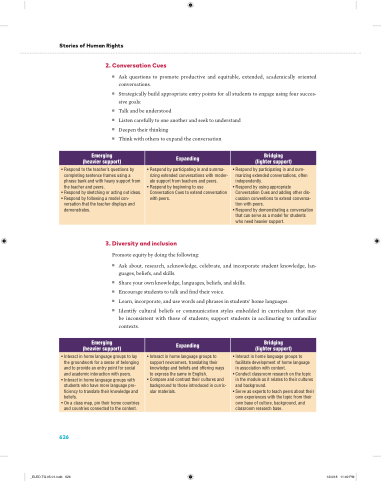Page 650 - EL Grade 5 Teacher Guide
P. 650
Stories of Human Rights
2. Conversation Cues
■ Ask questions to promote productive and equitable, extended, academically oriented conversations.
■ Strategically build appropriate entry points for all students to engage using four succes- sive goals:
■ Talk and be understood
■ Listen carefully to one another and seek to understand
■ Deepen their thinking
■ Think with others to expand the conversation
Emerging (heavier support)
Expanding
Bridging (lighter support)
• Respond to the teacher’s questions by completing sentence frames using a phrase bank and with heavy support from the teacher and peers.
• Respond by sketching or acting out ideas.
• Respond by following a model con-
versation that the teacher displays and demonstrates.
• Respond by participating in and summa- rizing extended conversations with moder- ate support from teachers and peers.
• Respond by beginning to use Conversation Cues to extend conversation with peers.
• Respond by participating in and sum- marizing extended conversations, often independently.
• Respond by using appropriate Conversation Cues and adding other dis- cussion conventions to extend conversa- tion with peers.
• Respond by demonstrating a conversation that can serve as a model for students who need heavier support.
3. Diversity and inclusion
Promote equity by doing the following:
■
■ ■ ■ ■
Ask about, research, acknowledge, celebrate, and incorporate student knowledge, lan- guages, beliefs, and skills.
Share your own knowledge, languages, beliefs, and skills.
Encourage students to talk and nd their voice.
Learn, incorporate, and use words and phrases in students’ home languages.
Identify cultural beliefs or communication styles embedded in curriculum that may be inconsistent with those of students; support students in acclimating to unfamiliar contexts.
Emerging (heavier support)
Expanding
Bridging (lighter support)
• Interact in home language groups to lay the groundwork for a sense of belonging and to provide an entry point for social and academic interaction with peers.
• Interact in home language groups with students who have more language pro- ciency to translate their knowledge and beliefs.
• On a class map, pin their home countries and countries connected to the content.
• Interact in home language groups to support newcomers, translating their knowledge and beliefs and offering ways to express the same in English.
• Compare and contrast their cultures and background to those introduced in curric- ular materials.
• Interact in home language groups to facilitate development of home language in association with content.
• Conduct classroom research on the topic in the module as it relates to their cultures and background.
• Serve as experts to teach peers about their own experiences with the topic from their own base of culture, background, and classroom research base.
626
_ELED.TG.05.01.indb 626
12/4/18 11:49 PM


